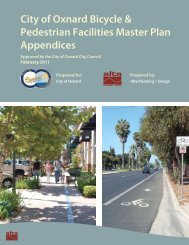View File - Development Services - City of Oxnard
View File - Development Services - City of Oxnard
View File - Development Services - City of Oxnard
You also want an ePaper? Increase the reach of your titles
YUMPU automatically turns print PDFs into web optimized ePapers that Google loves.
WATER RESOURCES TECHNICAL REPORTand increased pumping. Because these longer-term climatic patterns are not wellunderstood, the prediction <strong>of</strong> future groundwater levels also results in uncertainty.2.4 Surface WaterSurface water in the Santa Clara-Calleguas Hydrologic Unit consists <strong>of</strong> stream flow andremnant wetlands from the extensive estuarine wetlands that existed on the <strong>Oxnard</strong> Plainin the mid-1800s before development. Run<strong>of</strong>f from precipitation in the upland areas is thepredominant source <strong>of</strong> natural stream flow. Discharge <strong>of</strong> treated wastewater effluent,which began in the late 1930s, provides an additional source <strong>of</strong> water to stream flow.Stream flow has historically been diverted for agriculture for enhanced artificial recharge<strong>of</strong> the groundwater system. Surface water has been imported from outside theSanta Clara-Calleguas Unit since the 1950s as a source <strong>of</strong> potable surface water toVentura County and the <strong>Oxnard</strong> Plain.2.4.1 Stream FlowAs described above, the Santa Clara River and Calleguas Creek are the main watershedsthat drain Ventura County (Figures 2-1 and 2-2). The Santa Clara River drains the northernand eastern portions <strong>of</strong> the Santa Clara-Calleguas Hydrologic Unit, and Calleguas Creekdrains and southern portions <strong>of</strong> this unit. The Santa Clara River, which drains theheadwaters <strong>of</strong> the mountainous areas <strong>of</strong> northern Ventura County and northwesternLos Angeles County, is the largest river system in Southern California that remains in arelatively natural state. Its major tributaries are Piru, Hopper, Pole, Sespe, Santa Paula, andEllsworth Creeks. Calleguas Creek drains a predominantly agricultural area on the <strong>Oxnard</strong>Plain and empties into Mugu Lagoon, one <strong>of</strong> the Southern California few remaining largewetlands <strong>of</strong> Southern California. Its major tributaries are Conejo Creek and ArroyoSimi/Arroyo Las Posas. Revolon Slough is a smaller watershed that drains coastal areas onthe <strong>Oxnard</strong> Plain between the Santa Clara and Calleguas Creek watersheds. Its majortributaries are Arroyo Hondo and Beardsley Wash.Hydrographs for the Santa Clara River, Arroyo Simi, and Conejo Creek are provided inFigure 2-6 at the following locations:• Santa Clara River at County Line and Santa Clara River near Piru• Arroyo Simi near Simi and Arroyo Simi at Madera Road Bridge• Conejo Creek above Highway 101Stream flow gauging stations were first established on Arroyo Simi in 1934 and on ConejoCreek in the 1970s. Continuous gauging <strong>of</strong> stream flow at downstream sites began atMontalvo on the Santa Clara River in 1955, on Calleguas Creek above U.S. Highway 101 in1971, and at Camarillo in 1968. Most natural stream flow occurs from December throughApril in the winter and spring as flood flow. Construction <strong>of</strong> reservoirs and discharge <strong>of</strong>shallow groundwater (for dewatering) and treated wastewater effluent have contributed toregulated flow and modification <strong>of</strong> river systems in the basin. The Santa Clara River, PiruCreek, Arroyo Simi, and Conejo Creek all have components <strong>of</strong> regulated flow, whichincrease the mean flow and decrease the number <strong>of</strong> days with no flow.W112003002SCO LW1458.DOC/ 033390002 10
















